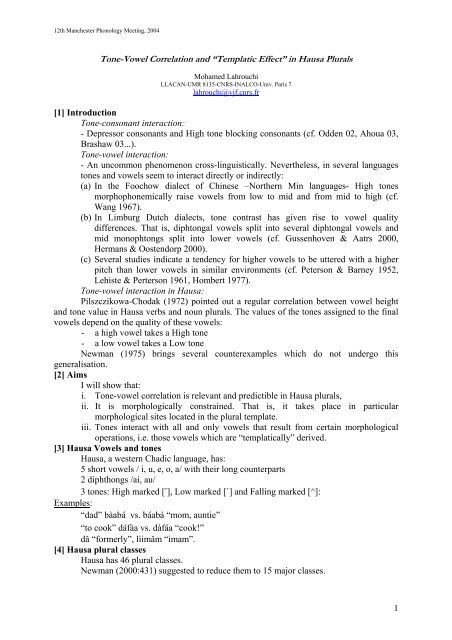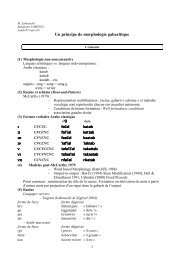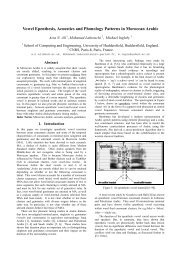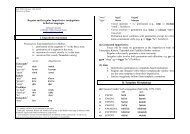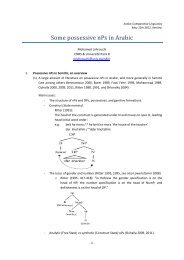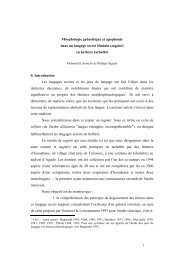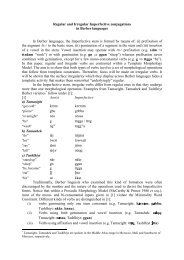in Hausa Plurals - Mohamed Lahrouchi
in Hausa Plurals - Mohamed Lahrouchi
in Hausa Plurals - Mohamed Lahrouchi
Create successful ePaper yourself
Turn your PDF publications into a flip-book with our unique Google optimized e-Paper software.
12th Manchester Phonology Meet<strong>in</strong>g, 2004<br />
Tone-Vowel Correlation and “Templatic Effect” <strong>in</strong> <strong>Hausa</strong> <strong>Plurals</strong><br />
<strong>Mohamed</strong> <strong>Lahrouchi</strong><br />
LLACAN-UMR 8135-CNRS-INALCO-Univ. Paris 7<br />
lahrouchi@vjf.cnrs.fr<br />
[1] Introduction<br />
Tone-consonant <strong>in</strong>teraction:<br />
- Depressor consonants and High tone block<strong>in</strong>g consonants (cf. Odden 02, Ahoua 03,<br />
Brashaw 03...).<br />
Tone-vowel <strong>in</strong>teraction:<br />
- An uncommon phenomenon cross-l<strong>in</strong>guistically. Nevertheless, <strong>in</strong> several languages<br />
tones and vowels seem to <strong>in</strong>teract directly or <strong>in</strong>directly:<br />
(a) In the Foochow dialect of Ch<strong>in</strong>ese –Northern M<strong>in</strong> languages- High tones<br />
morphophonemically raise vowels from low to mid and from mid to high (cf.<br />
Wang 1967).<br />
(b) In Limburg Dutch dialects, tone contrast has given rise to vowel quality<br />
differences. That is, diphtongal vowels split <strong>in</strong>to several diphtongal vowels and<br />
mid monophtongs split <strong>in</strong>to lower vowels (cf. Gussenhoven & Aatrs 2000,<br />
Hermans & Oostendorp 2000).<br />
(c) Several studies <strong>in</strong>dicate a tendency for higher vowels to be uttered with a higher<br />
pitch than lower vowels <strong>in</strong> similar environments (cf. Peterson & Barney 1952,<br />
Lehiste & Perterson 1961, Hombert 1977).<br />
Tone-vowel <strong>in</strong>teraction <strong>in</strong> <strong>Hausa</strong>:<br />
Pilszczikowa-Chodak (1972) po<strong>in</strong>ted out a regular correlation between vowel height<br />
and tone value <strong>in</strong> <strong>Hausa</strong> verbs and noun plurals. The values of the tones assigned to the f<strong>in</strong>al<br />
vowels depend on the quality of these vowels:<br />
- a high vowel takes a High tone<br />
- a low vowel takes a Low tone<br />
Newman (1975) br<strong>in</strong>gs several counterexamples which do not undergo this<br />
generalisation.<br />
[2] Aims<br />
I will show that:<br />
i. Tone-vowel correlation is relevant and predictible <strong>in</strong> <strong>Hausa</strong> plurals,<br />
ii. It is morphologically constra<strong>in</strong>ed. That is, it takes place <strong>in</strong> particular<br />
morphological sites located <strong>in</strong> the plural template.<br />
iii. Tones <strong>in</strong>teract with all and only vowels that result from certa<strong>in</strong> morphological<br />
operations, i.e. those vowels which are “templatically” derived.<br />
[3] <strong>Hausa</strong> Vowels and tones<br />
<strong>Hausa</strong>, a western Chadic language, has:<br />
5 short vowels / i, u, e, o, a/ with their long counterparts<br />
2 diphthongs /ai, au/<br />
3 tones: High marked [ ], Low marked [`] and Fall<strong>in</strong>g marked [^]:<br />
Examples:<br />
“dad” bàaba vs. baabà “mom, auntie”<br />
“to cook” dafàa vs. dàfaa “cook!”<br />
dâ “formerly”, lìimâm “imam”.<br />
[4] <strong>Hausa</strong> plural classes<br />
<strong>Hausa</strong> has 46 plural classes.<br />
Newman (2000:431) suggested to reduce them to 15 major classes.<br />
1
12th Manchester Phonology Meet<strong>in</strong>g, 2004<br />
Hellwig & Mc<strong>in</strong>tyre (2000) dist<strong>in</strong>guished 3 systems:<br />
(i) a semantic system –the oldest one- based on changes <strong>in</strong> tone pattern and vowel<br />
sequences<br />
(ii) a prosodic system, transitional<br />
(iii) a suffix system.<br />
[5] Data<br />
The vowels concerned with the correlation are underl<strong>in</strong>ed below:<br />
s<strong>in</strong>gular plural s<strong>in</strong>gular plural<br />
« old cow » guzumaa guzàarée « house » gidaa gidàayée<br />
« white » farii faraaree « type of drum » taushìi tafàashée<br />
« earth » kasaa kasàashée « stream» ràafii raafukàa<br />
« plot of cotton » garkaa garàakee « dog » kàrée karnukàa<br />
«grass bracelet » tafaa tafaafee « bicycle » kèekee kéekunàa<br />
« it<strong>in</strong>erant farkée fatàakée « axe » gàatarii gaaturàa<br />
trader »<br />
[6] Counterexamples Newman (1975).<br />
s<strong>in</strong>gular plural s<strong>in</strong>gular plural<br />
« boy » yaaròo yaàraa « clod of corn » damìi dâmmaa<br />
« friend » àbookii àbòokai « r<strong>in</strong>g » zoobèe zôbbaa<br />
« woman » màcè maataa « edge » géefèe gyâffaa<br />
« wife » mijìi mazaa « heathen » arnèe arnaa<br />
[7] Observations<br />
The examples <strong>in</strong> [5] show a regular correlation between the underl<strong>in</strong>ed vowels and the<br />
tones that they bear. That is:<br />
- a high vowel bears a High tone<br />
- a High tone is assigned to a low vowel /a/<br />
- lexical vowels, i.e. the first vowel of each stem, never undergo the correlation. It is<br />
usually the vowels that result from derivational operations that undergo the<br />
correlation, i.e. 2 nd and 3 rd vowels of the stem<br />
- the tone asssigned to the f<strong>in</strong>al vowel is systematically the opposite of the preced<strong>in</strong>g<br />
tone.<br />
[8] Tone patterns distribution<br />
Examples given <strong>in</strong> [5]<br />
S<strong>in</strong>gular Plural<br />
LH<br />
HHL<br />
HLH<br />
HL<br />
HLH<br />
HH<br />
HLH<br />
HHH HLH<br />
LHH<br />
HHL<br />
- only two patterns <strong>in</strong> the plurals given <strong>in</strong> [5]: HHL and HLH.<br />
- if <strong>in</strong>itial L <strong>in</strong> the s<strong>in</strong>gular then HHL pattern <strong>in</strong> the plural<br />
- if <strong>in</strong>itial H <strong>in</strong> the s<strong>in</strong>gular then HLH pattern <strong>in</strong> the plural (except tafaa > tafaafee)<br />
[9] Other observations<br />
- plurals given <strong>in</strong> [5] all conta<strong>in</strong> three consonants or two consonants with a<br />
reduplicated C 2 .<br />
2
12th Manchester Phonology Meet<strong>in</strong>g, 2004<br />
- A default consonant /k, n or y/ is suffixed to the plural forms when the stem<br />
conta<strong>in</strong>s less than three consonants,<br />
- the second vowel <strong>in</strong> the plural forms is always /a/. It becomes /u/ when preceded or<br />
followed by a velar consonant.<br />
The counterexamples given <strong>in</strong> [6] show the follow<strong>in</strong>g characteristics:<br />
- they do not undergo the tone-vowel correlation as their equivalents <strong>in</strong> [5]<br />
- their plurals all exhibit less than three consonants<br />
- they show vowel alternations between s<strong>in</strong>gular and plural<br />
- apart from some exceptions, their vowel alternation is regular: ii ⇒ aa, ii ⇒ ai, ee<br />
⇒ aa.<br />
[10] Afroasiatic <strong>in</strong>ternal -A- plurals<br />
The plurals <strong>in</strong> [5] all show an <strong>in</strong>ternal vowel <strong>in</strong>fixed between C 2 and C 3 or between<br />
reduplicated C 2 .<br />
The -A- plural formative is widely attested <strong>in</strong> Afroasiatic languages:<br />
s<strong>in</strong>gular plural s<strong>in</strong>gular plural<br />
Cl. Arabic raml rimaal “sand” Kotoko gnm gnàm “woman”<br />
kalb kilaab “dog” sym syàmè “ear”<br />
sirr asraar “secret” slèr slàrè “tooth”<br />
Mehri hootṛ hiitaạr “kid female” Ge’ez faras afraas “horse”<br />
bḳreet bkaạr “cow” hagar ahguur “town”<br />
ḳbooz ḳbawz “herd of camels” met amtaat “husband”<br />
[11] The plural Template<br />
Classical Arabic <strong>in</strong>ternal plurals: Kihm (2003) hypotheses a derivational empty site <strong>in</strong><br />
the plural template, located between the second and third root consonants. This site serves to<br />
connect the <strong>in</strong>ternal -A-.<br />
I suggest that all plurals <strong>in</strong> [5] are derived by use of the template given <strong>in</strong> [12]. This<br />
template conta<strong>in</strong>s two derivational sites: one located between R 2 and R 3 (R = root consonant)<br />
and the other is located at the end of the form.<br />
[12] R 1 •R 2 •{ } DS1 R 3 •{ } DS2<br />
The derivational sites are delimited by curly brackets. Full stops between Rs stand for<br />
vowels:<br />
- The first derivational site (DS1) is activated by the <strong>in</strong>ternal –a- which becomes –uwhen<br />
preceded or followed by a velar.<br />
- The second site (DS2) is filled by external material.<br />
- Both sites are activated.<br />
[13] Templatic effect<br />
My analysis of the tone-vowel correlation <strong>in</strong> plurals <strong>in</strong> [5] is based on the assumption<br />
that:<br />
“All and only vowels <strong>in</strong>side the two sites <strong>in</strong> [12] undergo the correlation.”<br />
The tone-vowel correlation is limited to at most 11 plural classes among 46<br />
[14] Newman’s counterexamples<br />
The plurals given <strong>in</strong> [6] do not undergo tone-vowel correlation because they have<br />
noth<strong>in</strong>g to do with templatic morphology. They behave completly differently from the<br />
examples <strong>in</strong> [5] <strong>in</strong> that:<br />
- they use none of the two derivational sites specified <strong>in</strong> [12]<br />
- their f<strong>in</strong>al vowels simply alternate with their s<strong>in</strong>gular counterparts.<br />
The vocalic alternations <strong>in</strong> [6] exhibit an apophonic derivation:<br />
3
12th Manchester Phonology Meet<strong>in</strong>g, 2004<br />
mijìi ⇒ mazaa<br />
I ⇒ A<br />
arnèe ⇒ arnaa<br />
I ⇒ A


